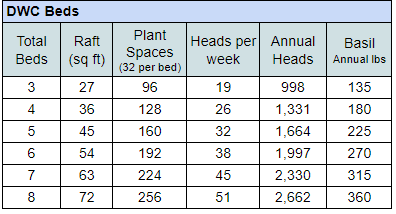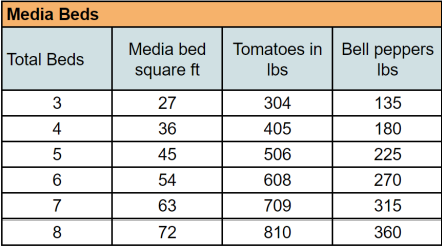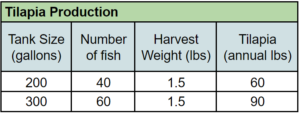Answering this question is like predicting the weather 3 months from now. Everyone’s growing results will be different because everyone’s environment is different. There are a variety of factors that will influence plant production in an aquaponic system such as but not limited to: Temperature, humidity, water quality, pH, nutrients, pest management, fish feeding, plant species, available light for plant photosynthesis etc. Most importantly, your ability to properly manage the system and environment and care for the fish, plants and bacteria will ultimately dictate your success. Managing a successful aquaponic garden does require that you learn about the fundamentals of plant and fish health as well as how to manage and adjust various water quality parameters to optimize the system. This is why taking an Aquaponic Class or purchasing the Aquaponic Gardening Book is a really good idea. Many of the most successful growers continue to stay active in our Aquaponic Gardening Forum to talk to other growers and learn about best practices, tips and tricks. The more knowledge you bring to your garden the more you will get out of it.
All of that said, here are a few tables that may be helpful for planning purposes. Please note that these tables assume that a single species of crop such as lettuce or tomatoes are planted per bed. The reality is most of our growers plant a wide variety of crops in each bed to diversify their food production. You will have to experiment with different species to determine plant yields and crop spacing in your system.

Table 1: Theoretical lettuce and basil production estimates
For the DWC beds, there are 32 planting spaces in each bed. Lettuce production estimates are based upon 32 planting spaces per bed with an average transplant to harvest time of 5 weeks (culture time). This table assumes that you are just growing lettuce and consistently rotating transplants from your nursery into the DWC bed as you harvest heads out of the bed. This weekly transplanting method allows you to achieve a very consistent harvest and yield which is what our larger scale farmers do to maximize production. To calculate heads per week, divide the total number of plant spaces by the culture time (5 weeks in this scenario) to get the number of heads you can theoretically harvest each week. This means that every week you need to replace the harvested heads with a new group of seedling transplants. In managing this rotation you would have 5 different weeks of growth in the system with a new group ready to be harvested each week. The key is to continue planting the same amount of seedlings each week so you are consistently replacing the harvested crop. Again, results will vary and these estimates are just for planning purposes. Annual lbs of basil is based upon an annual average yield of 5 lbs per sq ft. assuming the entire bed(s) was planted in basil.
 For Media Beds which are great for growing a wide variety of crops, we have assumed tomatoes in this example. Tomato production is based upon an average planting density of 4 sq ft per plant and an average yield of 45 lbs per plant. Again, your ability to properly manage nutrients, light, temperature and humidity among other factors will strongly influence the results you achieve. Bell pepper production is based upon an average planting density of 1 plant per sq ft with an average yield of 5 lbs. per plant. These estimates are based upon growers in climates that may be much different than yours.
For Media Beds which are great for growing a wide variety of crops, we have assumed tomatoes in this example. Tomato production is based upon an average planting density of 4 sq ft per plant and an average yield of 45 lbs per plant. Again, your ability to properly manage nutrients, light, temperature and humidity among other factors will strongly influence the results you achieve. Bell pepper production is based upon an average planting density of 1 plant per sq ft with an average yield of 5 lbs. per plant. These estimates are based upon growers in climates that may be much different than yours.
Fish Production – There are several varieties of fish that can be raised in aquaponics such as Tilapia, Catfish, Koi, Trout and Hybrid Striped Bass. Each species has unique temperature, feed and water quality requirements that will influence their health and growth rates in your system. For more in-depth articles and research on a wide variety of species please refer to the Fish Culture Section on the Regional Aquaculture Centers website.
For the purpose of illustrating some basic estimates of fish production we have chosen Tilapia in this example and are assuming a 12 month growth rate from fingerling size (5 grams) to an average harvest weight of around 1.5 lbs. Growth rates will vary significantly depending on water quality, temperature, daily feed rates and other factors. The stocking density for both size tanks is .3 lbs per gallon. Therefore 40 adult Tilapia weighing a total of 60 lbs would equal .3 lbs per gallon in a 200 gallon tank.

Tilapia Production Table for Aquabundance Systems
